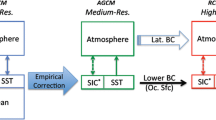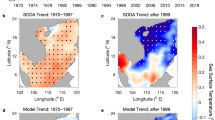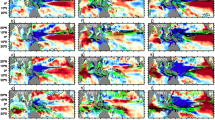Abstract
Future temperature distributions of the marginal Chinese seas are studied by dynamic downscaling of global CCSM3 IPCC_AR4 scenario runs. Different forcing fields from 2080–2099 Special Report on Emissions Scenarios (SRES) B1, A1, and A2 to 1980–1999 20C3M are averaged and superimposed on CORE2 and SODA2.2.4 data to force high-resolution regional future simulations using the Regional Ocean Modeling System (ROMS). Volume transport increments in downscaling simulation support the CCSM3 result that with a weakening subtropical gyre circulation, the Kuroshio Current in the East China Sea (ECS) is possibly strengthened under the global warming scheme. This mostly relates to local wind change, whereby the summer monsoon is strengthened and winter monsoon weakened. Future temperature fluxes and their seasonal variations are larger than in the CCSM3 result. Downscaling 100 years’ temperature increments are comparable to the CCSM3, with a minimum in B1 scenario of 1.2–2.0°C and a maximum in A2 scenario of 2.5–4.5°C. More detailed temperature distributions are shown in the downscaling simulation. Larger increments are in the Bohai Sea and middle Yellow Sea, and smaller increments near the southeast coast of China, west coast of Korea, and southern ECS. There is a reduction of advective heat north of Taiwan Island and west of Tsushima in summer, and along the southern part of the Yellow Sea warm current in winter. There is enhancement of advective heat in the northern Yellow Sea in winter, related to the delicate temperature increment distribution. At 50 meter depth, the Yellow Sea cold water mass is destroyed. Our simulations suggest that in the formation season of the cold water mass, regional temperature is higher in the future and the water remains at the bottom until next summer. In summer, the mixed layer is deeper, making it much easier for the strengthened surface heat flux to penetrate to the bottom of this water.
Similar content being viewed by others
References
Fang G, Zhao B, Zhu Y. 1991. Water volume transport through the Taiwan Strait and the continental shelf of the East China Sea measured with current meters. Oceanography of Asian Marginal Seas, 54: 345–358, http://dx.doi.org/10.1016/S0422-9894(08)70107-7.
Fang G, Wei Z, Choi B, Wang K, Fang Y, Li W. 2003. Interbasin freshwater, heat and salt transport through the boundaries of the East and South China Seas from a variable-grid global ocean circulation model. Sci. China Ser. D: Earth Sci., 46(2): 149–161.
Fairall C W, Bradley E F, Rogers D P, Edson J B, Young G S. 1096. Bulk parameterization of air-sea fluxes for tropical ocean-global atmosphere Coupled-Ocean Atmosphere Response Experiment. J. Geophys. Res., 101: 3 747–3 764.
Guo X, Miyazawa Y, Yamagata T. 2006. The Kuroshio onshore intrusion along the shelf break of the East China Sea: the origin of the Tsushima Warm Current. J. Phys. Oceanogr., 36: 2 205–2 231.
Ho C, Wang Y, Lei Z, Xu S. 1959. A preliminary study of the formation of Yellow Sea cold mass and its properties. Oceanologia et Limnologia Sinica, 11: 11–15. (in Chinese with English abstract)
Hu D. 1990. Chinese study on physical oceanography in the Southern Yellow Sea. Yellow Sea Research, 3: 13–20.
Ichikawa H, Beardsley R C. 1992. Temporal and spatial variability of volume transport of the Kuroshio in the East China Sea. Deep Sea Research Part I: Oceanographic Research Papers, 40(3): 583–605.
Intergovernmental Panel on Climate Change. 2007. IPCC Fourth Assessment Report(AR4), Climate Change 2007, Synthesis Report, p.44, http://www.ipcc.ch/publications_and_data/ar4/syr/en/contents.html.
Isobe A, Tawara S, Kaneko A, Kawano M. 1994. Seasonal variability in the Tsushima Warm Current, Tsushima-Korea Strait. Cont. Shelf Res., 14: 23–25.
Isobe A, Beardsley R C. 2006. An estimate of the cross-frontal transport at the shelf break of the East China Sea with the Finite Volume Coastal Ocean Model. J. Geophys. Res., 111: C03012, http://dx.doi.org/10.1029/2005JC003290.
Isobe A. 2008. Recent advances in ocean_circulation research on the Yellow Sea and East China Sea shelves. J. Oceanogr., 64: 569–584.
Jan S, Chao S Y. 2002. Seasonal variation of the circulation in the Taiwan Strait. J. Mar. Syst., 35: 249–268.
Lee J, Matsuno T. 2007. Intrusion of Kuroshio water onto the continental shelf of the East China Sea. J. Oceanogr., 63: 309–325.
Liu C T, Cheng S P, Chuang W S. 1998. Mean structure and transport of Taiwan Current (Kuroshio). Acta Oceanogr., 36: 159–176.
Liu N, Eden C, Dietze H, Wu D, Lin X. 2010. Model-based estimate of the heat budget in the East China Sea. J. Geophys. Res., 115: C08026, http://dx.doi.org/10.1029/2009JC005869.
Lin J. 2007. Interdecadal variability of ENSO in 21 IPCC AR4 coupled GCMs. Geophys. Res. Lett., 34: L12702, http://dx.doi.org/10.1029/2006GL028937.
Matsuno T, Lee J S, Yanao S. 2009. Influence of the Kuroshio on the water properties in the shelf. Ocean Science Discussions, 6: 741–764.
Mizuno S, Kawatate K, Kaneko A. 1991. Results of Direct Measurements of Kuroshio Currents in the East China Sea. Fukuoka: Kyushu University Research Institute for Applied Mechanics. p.1–18.
Nitani H. 1972. Beginning of the Kurohio. I n: Stommel H, Yoshida K eds. Kuroshio: Physical Aspects of the Japan Current. University of Washington Press, Seattle. p.129–163.
Sato Y, Yukimoto S, Tsujino H, Ishizaki H, Noda A. 2006. Response of North Pacific Ocean Circulation in a Kuroshio-resolving ocean model to an arctic oscillation (AO)-like change in northern hemisphere atmospheric circulation due to greenhouse-gas forcing. Journal of the Meteorological Society of Japan, 84: 295–309.
Schneider B, Latif M, Schmittner A. 2007. Evaluation of different methods to assess model projections of the future evolution of the Atlantic meridonal overturning circulation. J. Climate, 20: 2 121–2 132, http://dx.doi.org/10.1175/JCLI4128.1.
Sakamoto T T, Hasumi H, Ishii M, Emori S, Suzuki T, Nishimura T, Sumi A. 2005. Responses of the Kuroshio and the Kuroshio Extension to global warming in a highresolution climate model. Geophys. Res. Lett., 32: L14617, http://dx.doi.org/10.1029/2005GL023384.
Takikawa T, Yoon J, Cho K. 2005. The Tsushima Warm Current through Tsushima Straits estimated from ferryboat ADCP data. J. Phys. Oceanogr., 35: 1 154–1 168.
Teague W J, Jacobs G A, Perkins H T, Book J W, Chang K, Suk M. 2002. Low-frequency current observation in the Korea/Tsushima Strait. J. Phys. Oceanogr., 32: 1 621–1 641.
Toba Y, Tomizawa K, Kurasawa Y, Hanawa K. 1982. Seasonal and year-to-year variability of the Tsushima-Tsugaru Warm Current system with its possible cause. La Mer, 20: 41–51.
Vecchi G A, Soden B J. 2007. Global warming and the weakening of the tropical circulation. J. Climate, 20: 4 316–4 340, http://dx.doi.org/10.1175/JCLI4258.1.
Yuan Y C, Liu Y G, Su J L. 2001. Variability of the Kuroshio in the East China Sea during El Nino to La Nina phenomenon of 1997 and 1998. J. Geophys., 44: 1–10. (in Chinese with English abstract)
Zhang L, Wu L, Lin X, Wu D. 2010. Modes and mechanisms of sea surface temperature low-frequency variations over the coastal China seas. J. Geophys. Res., 115: C08031, http://dx.doi.org/10.1029/2009JC006025.
Author information
Authors and Affiliations
Corresponding author
Additional information
Supported by the National Basic Research Program of China (973 Program) (No. 2012CB417401), the Knowledge Innovation Program of Chinese Academy of Sciences (No. KZCX2-EW-201), and the Open Fund of Key Laboratory of Data Analysis and Applications, FIO (No. LDAA-2011-03)
Rights and permissions
About this article
Cite this article
Yu, X., Wang, F. & Tang, X. Future projection of East China Sea temperature by dynamic downscaling of the IPCC_AR4 CCSM3 model result. Chin. J. Ocean. Limnol. 30, 826–842 (2012). https://doi.org/10.1007/s00343-012-1290-9
Received:
Accepted:
Published:
Issue Date:
DOI: https://doi.org/10.1007/s00343-012-1290-9




